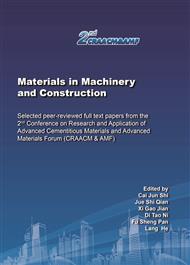[1]
H. Kühl, U.S. Patent 900,939.(1908).
Google Scholar
[2]
F. Pacheco-Torgal, J.A. Labrincha, C. Leonelli, et al, Handbook of alkali-activated cements, mortars and concretes, Woodhead Publishing, 2015, pp.1-10.
DOI: 10.1533/9781782422884.1
Google Scholar
[3]
J.L. Provis, Alkali-activated materials, Cem. Concr. Res. 114(2018) 40-48.
Google Scholar
[4]
A. Palomo, M.W. Grutzeck, M. T. Blanco, Alkali-activated fly ashes: A cement for the future, Cem. Concr. Res. 29(1999) 1323-1329.
DOI: 10.1016/s0008-8846(98)00243-9
Google Scholar
[5]
Y.L. Yi, M. Liska, A. Al-Tabbaa, Properties of Two Model Soils Stabilized with Different Blends and Contents of GGBS, MgO, Lime, and PC, J. Mate. Civil Eng. 26(2014) 267-274.
DOI: 10.1061/(asce)mt.1943-5533.0000806
Google Scholar
[6]
Y.L. Yi, C. Li, S.Y. Liu, Alkali-Activated Ground-Granulated Blast Furnace Slag for Stabilization of Marine Soft Clay, J. Mate. Civil Eng. 27(2015)04014146.
DOI: 10.1061/(asce)mt.1943-5533.0001100
Google Scholar
[7]
S. Pourakbar, B.B.K. Huat, A. Asadi, et al, Model Study of Alkali-Activated Waste Binder for Soil Stabilization, Int. J. of Geosynth. and Ground Eng. 2(2016)35.
DOI: 10.1007/s40891-016-0075-1
Google Scholar
[8]
C. Phetchuay, S. Horpibulsuk, C Suksiripattanapong, et al, Calcium carbide residue: Alkaline activator for clay–fly ash geopolymer, Constr. Build. Mater. 69(2014)285-294.
DOI: 10.1016/j.conbuildmat.2014.07.018
Google Scholar
[9]
Y.Y. Liu, C.W. Chang, A. Namdar, et al, Stabilization of expansive soil using cementing material from rice husk ash and calcium carbide residue, Constr. Build. Mater. 221(2019)1-11.
DOI: 10.1016/j.conbuildmat.2019.05.157
Google Scholar
[10]
J.R. Yu, Y.H. Chen, G. Chen, et al, Mechanical behaviour of geopolymer stabilized clay and its mechanism, J. Build. Mater. 23(2020) 364-371.
Google Scholar
[11]
S. Horpibulsuk, C. Phetchuay, A. Chinkulkijniwat, Soil Stabilization by Calcium Carbide Residue and Fly Ash, J. Mater. Civil Eng. 24(2012)184-193.
DOI: 10.1061/(asce)mt.1943-5533.0000370
Google Scholar
[12]
S. Horpibulsuk, C. Phetchuay, A. Chinkulkijniwat, et al, Strength development in silty clay stabilized with calcium carbide residue and fly ash, Soils Found. 53(2013) 477-486.
DOI: 10.1016/j.sandf.2013.06.001
Google Scholar
[13]
N. Cristelo, S. Glendinning, L. Fernandes, et al, Effect of calcium content on soil stabilisation with alkaline activation, Constr. Build. Mater. 29(2012)167-174.
DOI: 10.1016/j.conbuildmat.2011.10.049
Google Scholar
[14]
Y.L. Yi, X. Zheng, S.Y. Liu, et al. Comparison of reactive magnesia- and carbide slag-activated ground granulated blastfurnace slag and Portland cement for stabilisation of a natural soil, Appl. Clay Sci. 111 (2015)21-26.
DOI: 10.1016/j.clay.2015.03.023
Google Scholar
[15]
S.Y. Liu, G.H. Cai, Y.J. Du, et al, Engineering properties of carbonated reactive magnesia-stabilized silt under different activity index, Procedia Eng. 189(2017)158-165.
DOI: 10.1016/j.proeng.2017.05.026
Google Scholar
[16]
S. Siddiqua, P.N.M. Barreto, Chemical stabilization of rammed earth using calcium carbide residue and fly ash, Constr. Build. Mater. 169(2018) 364-371.
DOI: 10.1016/j.conbuildmat.2018.02.209
Google Scholar
[17]
S. Rios, N. Cristelo, A.V. da Fonseca, et al, Structural Performance of Alkali-Activated Soil Ash versus Soil Cement, J. Mate. Civil Eng. 28(2016)04015125.
DOI: 10.1061/(asce)mt.1943-5533.0001398
Google Scholar
[18]
A.H. Rafiean, E.N. Kani, A. Haddad, Mechanical and Durability Properties of Poorly Graded Sandy Soil Stabilized with Activated Slag, J. Mate. Civil Eng. 32(2020) 04019324.
DOI: 10.1061/(asce)mt.1943-5533.0002990
Google Scholar
[19]
The Professional Standards Compilation Group of the People's Republic of China. GB 50007-2011 Code for design of building foundation, China Architecture and Building Press, Beijing, (2012).
Google Scholar
[20]
A. Fernéndez-Jiménez, A. Palomo, Characterization of fly ashes Potential reactivity as alkaline cements, Fuel 82(2003)2259-2265.
DOI: 10.1016/s0016-2361(03)00194-7
Google Scholar
[21]
J.J. Geng, M. Zhou, Y.X. Li, et al, Comparison of red mud and coal gangue blended geopolymers synthesized through thermal activation and mechanical grinding preactivation, Constr. Build. Mater. 153(2017)185-192.
DOI: 10.1016/j.conbuildmat.2017.07.045
Google Scholar
[22]
M. Yaghoubi, A. Arulrajah, M. M. Disfani, et al, Impact of field conditions on the strength development of a geopolymer stabilized marine clay, Appl. Clay Sci. 167(2019) 33-42.
DOI: 10.1016/j.clay.2018.10.005
Google Scholar
[23]
I. Ismail, S.A. Bernal, J.L. Provis, et al, Modification of phase evolution in alkali-activated blast furnace slag by the incorporation of fly ash, Cem. Concr. Compos. 45(2014)125-135.
DOI: 10.1016/j.cemconcomp.2013.09.006
Google Scholar
[24]
S. Horpibulsuk, A. Kampala, C. Phetchuay, et al, Calcium carbide residue - A cementing agent for sustainable soil stabilization, Geotech. Eng. 46(2015)22-27.
Google Scholar
[25]
S. Vichan, R. Rachan, Chemical stabilization of soft Bangkok clay using the blend of calcium carbide residue and biomass ash, Soils Found. 53(2013)272-281.
DOI: 10.1016/j.sandf.2013.02.007
Google Scholar


